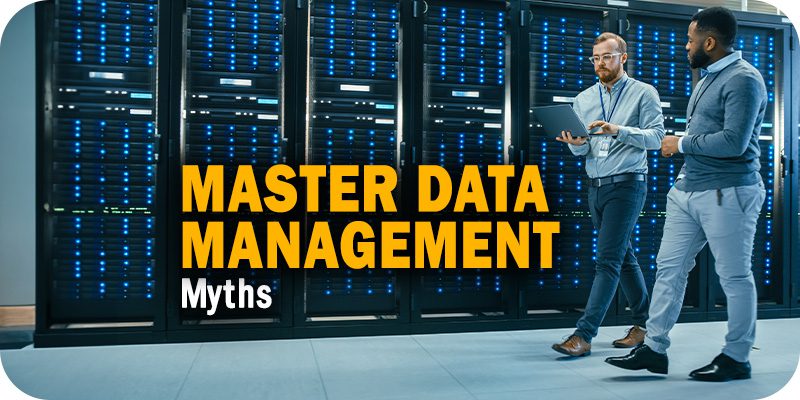Solutions Review editors created this short resource highlighting the most common master data management myths to stand clear of.
In the age of data-driven decision-making, effective master data management (MDM) has become essential for organizations seeking to maintain data integrity, improve operational efficiency, and enhance customer experiences. However, misconceptions and myths surrounding MDM can hinder organizations from fully leveraging its potential. In this article, we aim to debunk some of the greatest MDM myths, providing insights and best practices to help organizations harness the true power of MDM and achieve data harmony.
Master Data Management Myths
Myth 1: Master Data Management is Only for Large Enterprises
One common misconception is that MDM is exclusively relevant to large enterprises with complex data ecosystems. In reality, organizations of all sizes can benefit from implementing MDM practices. Whether a small business or a multinational corporation, MDM helps in establishing consistent and accurate master data across systems, enhancing data quality, and driving better decision-making. By tailoring MDM strategies to their specific needs and scalability requirements, organizations can effectively manage and leverage their master data assets, regardless of their size.
Myth 2: Master Data Management is a One-Time Project
A prevalent myth surrounding MDM is that it is a one-time project with a definite endpoint. However, MDM is an ongoing process that requires continuous attention and maintenance. Master data evolves as business processes change, new data sources emerge, or regulatory requirements evolve. Organizations must establish robust data governance frameworks, data stewardship practices, and data quality management processes to ensure the accuracy, consistency, and relevance of master data over time. Treating MDM as a continuous effort enables organizations to adapt and align their master data with evolving business needs.
Myth 3: Master Data Management is an IT Responsibility
Another misconception is that MDM falls solely within the purview of the IT department. While IT plays a critical role in implementing MDM solutions and technologies, effective MDM requires collaboration between IT and business stakeholders. Business users, data owners, and data stewards possess valuable domain knowledge and play an active role in defining data standards, data governance policies, and data validation rules. By involving all relevant stakeholders, organizations can ensure that master data is accurate, relevant, and aligned with business objectives.
Myth 4: Master Data Management is Expensive and Time-Consuming
There is a misconception that implementing MDM is a costly and time-consuming endeavor. While MDM requires investment in tools, technologies, and resources, the long-term benefits outweigh the initial costs. MDM streamlines data processes, reduces data redundancy, improves data quality, and enhances data consistency across systems. By implementing MDM best practices, organizations can reduce operational costs, optimize data-related workflows, and improve overall business efficiency. Proper planning, resource allocation, and leveraging MDM technologies can make the implementation and maintenance of MDM solutions more cost-effective.
Myth 5: Master Data Management is a Technical Issue, Not a Business Priority
Some organizations view MDM as a technical issue rather than a business priority. However, MDM has a direct impact on business outcomes, customer satisfaction, and regulatory compliance. High-quality master data enables organizations to make accurate forecasts, provide personalized customer experiences, ensure regulatory compliance, and drive strategic decision-making. By recognizing MDM as a business priority, organizations can prioritize data governance, establish data stewardship roles, and integrate MDM initiatives with broader business strategies.
Final Thoughts
Master data management is a critical component of effective data governance and business success. By debunking the myths surrounding MDM, organizations can harness its true potential. MDM is not exclusive to large enterprises or limited to the IT department alone. It is an ongoing process that requires collaboration, continuous effort, and a focus on data governance and data quality. Implementing MDM practices enables organizations to establish a single source of truth, improve data quality, and drive informed decision-making across the organization.
Debunking the myths surrounding master data management is crucial for organizations to fully leverage its power and achieve data harmony. MDM is not limited to large enterprises or confined to the IT department; it is a cross-functional initiative that requires collaboration between IT and business stakeholders. By recognizing MDM as an ongoing effort, prioritizing data governance, investing in the right tools and technologies, and aligning MDM with broader business objectives, organizations can optimize their master data, enhance data quality, and drive business success. Effective master data management paves the way for accurate insights, streamlined processes, and improved decision-making, enabling organizations to stay ahead in the data-driven world.
- The 5 Greatest Data Lake Myths and How to Avoid Them - June 30, 2023
- The 5 Greatest Master Data Management Myths and How to Avoid Them - June 30, 2023
- The 5 Greatest Metadata Management Myths and How to Avoid Them - June 30, 2023





